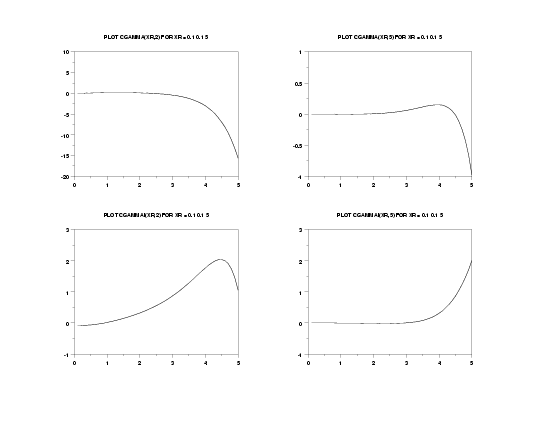CGAMMA
Name:
Type:
Purpose:
Compute the gamma function with complex arguments.
Description:
The complex gamma function is defined as:
where z is a complex number with a positive real component.
Dataplot computes this function using the CGAMMA routines
from "Computation of Special Functions" (see the References
section below).
Syntax 1:
LET <yr> = CGAMMA(<xr>,<xc>)
<SUBSET/EXCEPT/FOR qualification>
where <xr> is a variable, number, or parameter containing
positive values;
<xc> is a variable, number, or parameter;
positive values;
<yr> is a variable or a parameter (depending on what
<xr> and <xc> are) where the computed gamma
values are stored;
and where the <SUBSET/EXCEPT/FOR qualification> is optional.
This syntax computes the real component of the complex
gamma function. The and values are the real and
complex components of the input argument respectively.
Syntax 2:
LET <yc> = CGAMMAI(<xr>,<xc>)
<SUBSET/EXCEPT/FOR qualification>
where <xr> is a variable, number, or parameter containing
positive values;
<xc> is a variable, number, or parameter;
positive values;
<yr> is a variable or a parameter (depending on what
<xr> and <xc> are) where the computed gamma
values are stored;
and where the <SUBSET/EXCEPT/FOR qualification> is optional.
This syntax computes the complex component of the complex
gamma function. The and values are the real and
complex components of the input argument respectively.
Examples:
LET A = CGAMMA(1,2)
LET A = CGAMMAI(1,2)
LET YR = CGAMMA(XR,2)
LET YC = CGAMMAI(XR,2)
LET YR = CGAMMA(XR,XC)
LET YC = CGAMMAI(XR,XC)
Note:
Library functions are distinguished from let subcommands
in the following ways.
- Functions enclose the input value in parenthesis. Let
subcommands use spaces.
- Functions can accept (and return) either parameters
(i.e., single values) or variables (i.e., an array of
values) while let subcommands are specific in which they
accept as input and what they return as output.
- Functions can accept expressions while let subcommands
do not. For example, the following is legal:
For let subcommands, you typically have to do something
like the following:
LET YTEMP = Y**2 + 8
LET A = SUM YTEMP
Default:
Synonyms:
Related Commands:
|
CLNGAM
|
= Compute the complex log gamma function.
|
|
CBETA
|
= Compute the complex beta function.
|
|
CLNBETA
|
= Compute the complex log beta function.
|
|
GAMMA
|
= Compute the gamma function.
|
|
GAMMAI
|
= Compute the incomplete Gamma function.
|
|
DIGAMMA
|
= Compute the digamma function.
|
Reference:
"Computation of Special Functions", Shanjie Zhang and Jianming
Jin, John Wiley and Sons, 1996, pp. 182-184.
"Handbook of Mathematical Functions, Applied Mathematics Series,
Vol. 55", Abramowitz and Stegun, National Bureau of Standards,
1964 (chapter 6).
Applications:
Implementation Date:
Program:
MULTIPLOT 2 2
MULTIPLOT CORNER COORDINATES 5 5 95 95
TITLE AUTOMATIC
PLOT CGAMMA(XR,2) FOR XR = 0.1 0.1 5
PLOT CGAMMA(XR,5) FOR XR = 0.1 0.1 5
PLOT CGAMMAI(XR,2) FOR XR = 0.1 0.1 5
PLOT CGAMMAI(XR,5) FOR XR = 0.1 0.1 5
END OF MULTIPLOT

Date created: 6/5/2001
Last updated: 4/4/2003
Please email comments on this WWW page to
alan.heckert@nist.gov.
|


